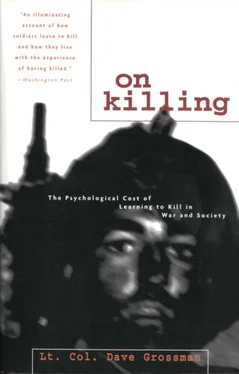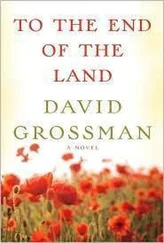Fear of death and injury is not the only, or even the major, cause of psychiatric casualties in combat. That is not to say that there is not some wisdom in this common understanding of battle, but the whole truth is far more complex and horrible. This is also not to suggest that the carnage and death of battle are not horrible and that the fear of violent death and injury is not a traumatic thing. These factors by themselves, however, are not sufficient to cause the mass exodus of psychiatric casualties found on the modern battlefield.
There are deeper underlying causes for the psychiatric casualties suffered by soldiers in combat. Resistance to overt aggressive confrontation, in addition to the fear of death and injury, is responsible for much of the trauma and stress on the battlefield. Thus, the Reign of Fear is represented as only one contributing factor in the soldier’s dilemma. Fear, combined with exhaustion, hate, horror, and the irreconcilable task of balancing these with the need to kill, eventually drives the soldier so deeply into a mire of guilt and horror that he tips over the brink into that region that we call insanity. Indeed, fear may be one of the least important of these factors.
Nonkillers are frequently exposed to the same brutal conditions as killers, conditions that cause fear, but they do not become psychiatric casualties. In most circumstances in which nonkillers are faced with the threat of death and injury in war, the instances of psychiatric casualties are notably absent. These circumstances include civilian victims of strategic bombing attacks, civilians and prisoners of war under artillery fire and bombings, sailors on board ship during combat, soldiers on reconnaissance missions behind enemy lines, medical personnel, and officers in combat.
Fear and Civilian Victims of Bombing Attacks
The Italian infantry officer Giulio Douhet became the world’s first recognized airpower theoretician with the publication of his book Command of the Air in 1921. Douhet declared, “The disintegration of nations [which] in the last war was brought about by [attrition] will be accomplished directly by… aerial forces.”
Prior to World War II, psychologists and military theoreticians such as Douhet predicted that mass bombing of cities would create the same degree of psychological trauma seen on the battlefield in World War I. During World War I the probability of a soldier becoming a psychiatric casualty was greater than that of his being killed by enemy fire. As a result of this, authorities envisioned vast numbers of “gibbering lunatics” being driven from their cities by a rain of bombs. Among civilians the impact was projected to be even worse than that seen in combat. When the horror of war touched women, children, and the elderly, rather than trained and carefully selected soldiers, the psychological impact was sure to be too great, and even more civilians than soldiers were expected to snap.
This body of theory, established by Douhet and later echoed by many other authorities, played a key role in establishing the theoretical foundation for the German attempt to bomb Britain into submission at the beginning of World War II and the subsequent Allied attempt to do the same to Germany. This strategic bombing of population centers was motivated by quite reasonable expectations of mass psychiatric casualties resulting from the strategic bombing of civilian populations.
But they were wrong.
The carnage and destruction, and the fear of death and injury caused by the months of continuous blitz in England during World War II were as bad as anything faced by any frontline soldier. Relatives and friends were mutilated and killed, but in a strange sort of way, that was not the worst of it. These civilians suffered one indignity that most soldiers need never face. In 1942, Lord Cherwell wrote: “Investigation seems to show that having one’s house demolished is most damaging to morale. People seem to mind it more than having their friends or even relatives killed.”
For the Germans it was worse. The might of the vast British Empire was brought to bear on the German population via Britain’s nighttime area bombing. At the same time, the United States devoted its efforts to “precision” daylight bombing. Day and night for months, even years, the German people suffered horribly.
During the months of firebombings and carpet bombings the German population experienced the distilled essence of the death and injury suffered in combat. They endured fear and horror on a magnitude such as few will ever live to see. This Reign of Fear and horror unleashed among civilians is exactly what most experts hold responsible for the tremendous percentages of psychiatric casualties suffered by soldiers in battle.
And yet, incredibly, the incidence of psychiatric casualties among these individuals was very similar to that of peacetime. There were no incidents of mass psychiatric casualties. The Rand Corporation study of the psychological impact of air raids, published in 1949, found that there was only a very slight increase in the “more or less long-term” psychological disorders as compared with peacetime rates. And those that did appear seemed to “occur primarily among already predisposed persons.” Indeed, bombing seemed to have served primarily to harden the hearts and empower the killing ability of those who endured it.
When faced with the failure of their predictions, postwar psychologists and psychiatrists scrambled to find a reason for the obstinate failure of the populations of Germany and England to become mass psychiatric casualties in response to strategic bombing. They finally used the theory of gain through illness as a model to explain what had occurred. This held that these individuals failed to become “ill” because they simply had nothing to gain by doing so.
The theory of gain through illness, however, fails for two reasons: soldiers in combat will become psychiatric casualties even when they have nothing to gain by doing so — such is the nature of insanity — and second, these individuals did have much to gain by “letting slip the bonds of reality” and escaping into the countryside, or better yet escaping to the psychiatric clinics that were usually located far from the targets of strategic bombing.
Fear and Prisoners of War as Artillery and Bombing Victims
Gabriel notes that studies from both the First and Second World Wars show that prisoners of war did not suffer psychiatric reactions when they were subjected to artillery attack or aerial bombardment, but their guards did. Here we see a situation in which noncombatants (prisoners) were not traumatized by death and destruction, while the combatants (guards) with them were. The theory of gain through illness has been applied to explain this disparity; that is, the guards could gain by becoming psychiatric casualties and departing to the nearest psychiatric clearing station, while the prisoners had nothing to gain and nowhere to go, so they elected not to become psychiatric casualties. But this theory does not bear up under careful scrutiny.
Soldiers who are surrounded and without cover will flee from battle, even when they have nothing to gain by doing so. An excellent example of this can be seen in one of Custer’s cavalry units, which was cut off and surrounded by the Indians for two days before being rescued. (Yes, some of Custer’s 7th Cavalry, at a different location under the command of Major Reno, did survive the Little Big Horn. Only the ones with Custer were all killed.) According to Gabriel many of these soldiers, pretending to be ill or wounded, left their defensive positions for the medical station, even though it offered no protection. Indeed, the medical station was exposed to hostile fire and was very possibly less safe than positions on the perimeter. This example makes an important point about gain through illness: combatants will try to get out of the battle (a situation where they are required to kill) even when it puts them at risk.
Читать дальше







